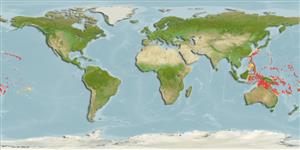Common names from other countries
Environment: milieu / climate zone / depth range / distribution range
Ecología
marino asociado a arrecife; rango de profundidad 2 - 400 m (Ref. 1602). Tropical; 32°N - 24°S, 117°E - 143°W (Ref. 57368)
Pacific Ocean: Philippines and Indonesia to the Tuamoto Islands, north to southern Japan, south to the Great Barrier Reef.
Tamaño / Peso / Age
Maturity: Lm ? range ? - ? cm
Max length : 35.0 cm TL macho / no sexado; (Ref. 9710)
Espinas dorsales (total) : 6 - 7; Radios blandos dorsales (total) : 14 - 15; Espinas anales: 2; Radios blandos anales: 9 - 11.
Hides during the day and venture out at night to feed, tending to occur along steep drop-offs near caves on dark, moonless nights. Feeds on zooplankton. The large, deep water form is occasionally collected by fishing at depths of 200 to 400 m. Caught with cast nets in shallow waters of the Philippines. Forms aggregations (Ref 90102).
Life cycle and mating behavior
Maturities | Reproducción | Spawnings | Egg(s) | Fecundities | Larva
McCosker, J.E. and R.H. Rosenblatt, 1987. Notes on the biology, taxonomy, and distribution of flashlight fishes (Beryciformes: Anomalopidae). Jap. J. Ichthyol. 34(2):157-164. (Ref. 5004)
IUCN Red List Status (Ref. 130435)
CITES (Ref. 128078)
Not Evaluated
Threat to humans
Harmless
Human uses
Pesquerías: sin interés; Acuario: Comercial; carnada: occasionally
Herramientas
Special reports
Download XML
Fuentes de Internet
Estimates based on models
Preferred temperature (Ref.
115969): 17.9 - 27.8, mean 24.1 (based on 244 cells).
Phylogenetic diversity index (Ref.
82804): PD
50 = 1.0020 [Uniqueness, from 0.5 = low to 2.0 = high].
Bayesian length-weight: a=0.01122 (0.00514 - 0.02450), b=3.04 (2.87 - 3.21), in cm Total Length, based on all LWR estimates for this body shape (Ref.
93245).
Nivel trófico (Ref.
69278): 3.4 ±0.45 se; based on food items.
Fishing Vulnerability (Ref.
59153): Low vulnerability (25 of 100).
